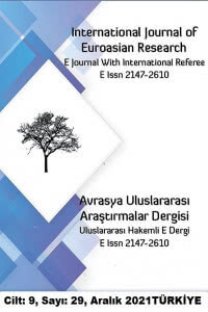ERMENİ HARFLİ KIPÇAK TÜRKÇESİNDE İKİLEMELER
Kipchak Turkish in Armenian Script, morphology
___
- ÇAĞATAY, Saadet, (1978), Türk Lehçeleri Üzerine Denemeler, Ankara.
- ERCĠLASUN, Ahmet Bican, (2009), Başlangıçtan Yirminci Yüzyıla Türk Dili Tarihi, Ankara: Akçağ Yayınları.
- ERDEM, Mehmet Dursun, (2005), “Harezm Türkçesinde İkilemeler ve Yinelemeler Üzerine”, Bilig S: 33: 189-225.
- ERGĠN, Muharrem, (1988) Türk Dil Bilgisi, Ġstanbul: Bayrak Yayınları.
- GARKAVETS, A. N. (1979), Konvergentsiya Armyano-Kıpçakskogo Yazıka k Slavyanskimi v XVI-XVII vv, Kiev: Naukova Dumka.
- GARKAVETS, A. N. (1987). Kıpçakskie Yazıki: Kumanskiy i Armyano-Kıpçakskiy (Glava 2. Armyano-Kıpçakskiy Yazık Po Pamyatnikam XVI-XVII vv., Alma-Ata: Nauka.
- GARKAVETS, A. N.; HURġUDYAN, E. (2001), Armenian-Qypchaq Psalter Written by Deacon Lussig Drom Lviv 1575/1580, Almatı: DeĢt-i Kıpçak.
- GARKAVETS, A. N. (2010). Kıpçakskoe Pis'mennoe Nasledie III. Kıpçakskiy Slovar'. Almaty: Kasean Baur. [KS : Kıpçakskoye Pismennoye Naslediye] GENCAN, Tahir Nejat, (1979), Dilbilgisi, Ankara: Türk Dil Kurumu Yayınları.
- HATĠPOĞLU, Vecihe (1981), Türk Dilinde İkileme, Ankara: Ankara Üniversitesi.
- KASAPOĞLU ÇENGEL, Hülya, (2008). “Urum Diyalektlerinde Tipik Kıpçak Özellikleri”, Prof. Dr. Ahmet Bican ERCİLASUN Armağanı, Ankara: Akçağ Yayınları, s. 252-264.
- KASAPOĞLU ÇENGEL, Hülya, (2012). “Ermeni Harfli Kıpçak Türkçesi” Dil Araştırmaları, S. 10, 17-81.
- KORKMAZ, Zeynep (1992). Gramer Terimleri Sözlüğü, Ankara: TDK Yay.
- SEV, Gülsel, “Divanü Lügat’it Türk’te İkilemeler”, Türk Dili Dergisi, Sayı: 634: 497- 510.
- TOPRAK, Funda, (2005), “Harezm Türkçesinde İkilemeler”, Türk Dünyası Incelemeleri Dergisi, C. V, S. 2: 277-292.
- TUNA, Osman Nedim (1948), “Türkçede Tekrarlar”, ĠÜ, Edebiyat Fakültesi Türk Dili ve Edebiyatı Dergisi, C. III, Ġstanbul, s. 429-447.
- ISSN: 2147-2610
- Yayın Aralığı: 4
- Başlangıç: 2012
- Yayıncı: Kürşat Öncül
KIPCHAKS IN THE BATTLES AGAINST THE TATARS
ATAMIZIN DUASI”NIN ERMENİ KIPÇAKÇASI BİR VERSİYONU
ГЕНЕАЛОГИИ (ШЕЖИРЕ) КАРА-КЫПЧАКОВ КАК ИСТОРИЧЕСКИЙ ИСТОЧНИК
“ATAMIZIN DUASI”NIN ERMENİ KIPÇAKÇASI BİR VERSİYONU
ERMENİ HARFLİ KIPÇAK TÜRKÇESİNDE İKİLEMELER
KARAY TÜRKÇESİNDEKİ -Adoğon / -ydoğon EKİ ÜZERİNE
GEÇ ORTAÇAĞ’DA İPEK YOLUNDA DİPLOMAT VE AJAN OLARAK TÜCCARLAR
KARAYCANIN BUGÜNKÜ DURUMU:MYKOLAS FİRKOVİÇİUS İLE MARK LAVRİNOVİÇİUS’LERİN ANISINA
А.К. КУШКУМБАЕВ. ГЕНЕАЛОГИЯ (ШЕЖИРЕ) КАРА-КЫПЧАКОВ КАК ИСТОРИЧЕСКИЙ ИСТОЧНИК (13 С.)
